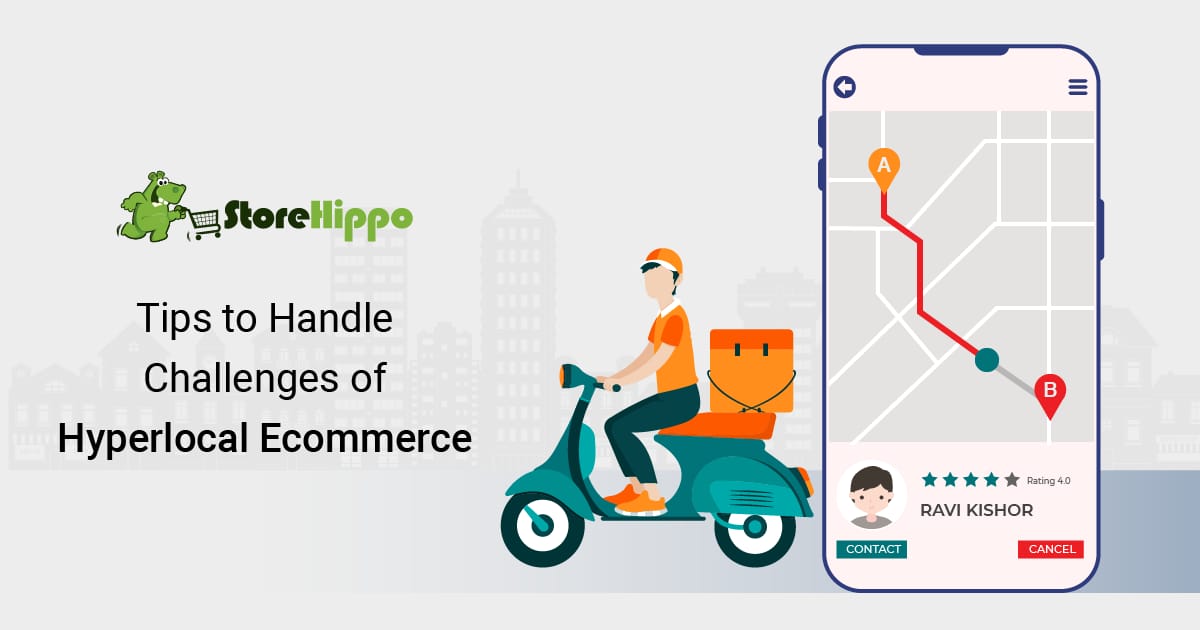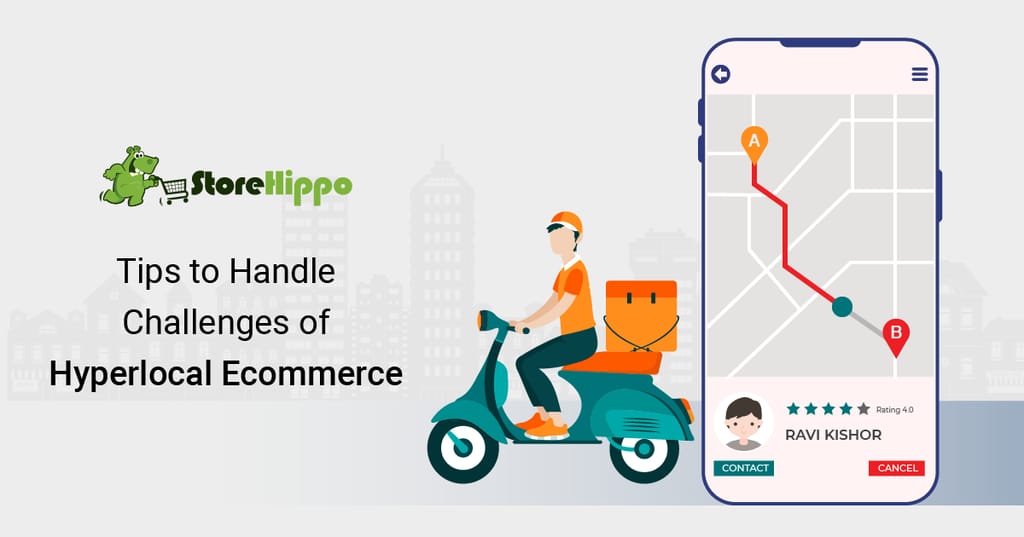Does the idea of owning a hyperlocal ecommerce store appeal to you? Well, with hyperlocal becoming the go-to buying option for millions across the globe, it is no wonder that you are exploring the business model for your enterprise business.
The popularity of “nearby” searches and customer preference for quick deliveries have been the driving forces behind the success of the hyperlocal business model. From food delivery to grocery and daily essentials, buyers now want their orders to be delivered instantly.
Let’s check some latest data that further underlines the growth of hyperlocal commerce:
- 48% of all e-commerce buyers in India are hyperlocal shoppers
- 52% growth is expected in the number of hyperlocal buyers in India in 2022
- 214 million hyperlocal buyers in India by the end of 2022
- $3,634.3 billion is the forecasted size of hyperlocal services market by 2027
- 17.9% is the expected CAGR of hyperlocal services from 2021 to 2027
Source: Watconsult
The figures clearly highlight the buyer sentiments and preference for faster local deliveries. But before we delve deeper, let’s understand which businesses are the best fit to adopt this business model.
Table of Contents
- What is Hyperlocal Ecommerce?
- What are the different industries that can implement the Hyperlocal Business model?
- What are the benefits of adopting the Hyperlocal Ecommerce approach for enterprise brands?
- What are the challenges of Hyperlocal Ecommerce and how to overcome them?
- Challenge 1: Customer Engagement
- Solution: Create a user-friendly website
- Challenge 2: Reaching a wider audience
- Solution: Leverage your vendor network
- Challenge 3: Difficulty adding M-commerce sales channels
- Solution: Opt for the mobile-ready solution provider
- Challenge 4: Not getting good marketing ROI
- Solution: Practice targeted marketing
- Challenge 5: Delivery Hiccups
- Solution: Streamline Logistics with automated Shipping solutions
- Overcome challenges and lead your hyperlocal ecommerce store towards growth
What is Hyperlocal Ecommerce?
Hyperlocal commerce is a business model where businesses focus on catering to a given locality and geographically nearby customers. Businesses decide on a given range of a city (say 5 km to 15 km) for which they fulfil on-demand online orders fairly quickly. Customers can use hyperlocal marketplace websites, mobile apps, social commerce or any other digital commerce channels to place their orders.
Businesses typically fulfil hyperlocal orders with their own fleet of delivery boys or in partnership with last-mile delivery partners from reputed delivery service providers.
What are the different industries that can implement the Hyperlocal Business model?
Enterprise businesses are increasingly opting for the hyperlocal approach as it enables them to target customers directly. By setting up location-based multi-store ecommerce network, brands can remove the middlemen and retail stores and establish a better connect with their buyers.
While many industries can benefit from the hyperlocal model the most popular industries where buyers have opted for the hyperlocal services are:
Hyperlocal Services Used ( By industry type)
- Local food delivery businesses - 52%
- Local Logistics - 40%
- Groceries and Vegetables - 38%
- Home services- 32%
- E-Pharmacy- 26%
Source: Watconsult
The pandemic conditioned buyers to go for online orders. Even after the crisis is over, buyers who experienced the ease and flexibility of online shopping offers have stayed loyal to hyperlocal marketplaces.
What are the benefits of adopting the Hyperlocal Ecommerce approach for enterprise brands?
Brands can get a number of benefits by opting for the hyperlocal e-commerce model. Some prominent benefits are as follows:
Win customer trust and loyalty with improved and quick buying experiences
Quickly scale up product offerings by onboarding local vendors on your multi-store ecommerce marketplace
Retain customers better with quick deliveries
Offer more convenience to buyers with customized deliveries
Ensure a more engaging buying experience by having a phygital presence through local vendor stores
Get better order volume with repeat orders from happy customers
Win customers as brand ambassadors who spread the word about your brand through word of mouth promotion
Grow the reach of your hyperlocal marketplace’s vendor partners
Get higher marketing ROI with targeted campaigns for different buyer groups
While the business model offers many benefits the sailing is not all smooth.
Yes, a lot of start-ups like Ola café and Ola store or FlipKart ‘Nearby’ failed to live up to customer expectations and closed soon enough. But these could be learnings with strong takeaways, helping you overcome your business hurdles.
So you see, it might take some glitches for your hyperlocal ecommerce store to become your customers’ favourite. Right from the products and vendors to marketing and shipment, there can be several challenges that can pull your business into a downward spiral.
Let us check some of these challenges and find out ways to overcome them.
What are the challenges of Hyperlocal Ecommerce and how to overcome them?
Well, certainly every business has its own set of challenges and so do hyperlocal systems. But solutions always follow! That’s how popular brands like BigBasket, Urban Company and Grofers have survived.
Identifying the key challenges that can block your growth is the first step to handling them. Most of the time, you can overcome the roadblock in a few simple ways and save your hyperlocal business from going south.
Challenge 1: Customer Engagement
Alike every other business the topmost challenge for hyperlocal commerce remains engaging and converting buyers. With a plethora of online stores, local shops and popular marketplaces, establishing a new brand with nearby delivery solutions is no mean feat. However, brands can easily overcome this challenge by building a user-friendly portal.
Solution: Create a user-friendly website
Having a simple yet user-friendly website is the first step to overcoming the problem of customers moving to competitor businesses or abandoning your pages too quickly. If shoppers do not engage with your hyperlocal marketplace website, and don’t find it appealing or user-friendly, then what chance do you stand to convert them?
A user-friendly website means, you need to focus on;
A relevant design theme
Planned information architecture, i.e. ‘click here’, ‘order now’ buttons
Well-formatted content
Fast load time
Effective navigation such as faceted search option
StoreHippo provides you with a rich theme library to create a unique website design for your hyperlocal ecommerce store. Its drag-and-drop tools ensure you can tweak the themes easily. Also, the platform’s inbuilt CMS helps you craft compelling content in the form of blogs, and other user-generated content. You can also offer faceted search filters for customers so that they can find your product easily. For example for a grocery store, you can run filters depending on product weight, cost, etc.
With StoreHippo’s amazing features, you can create a user-friendly website instantly. A step closer to avoiding a bumpy ride in your ecommerce journey, isn’t it?
Challenge 2: Reaching a wider audience
As the name suggests, the business model is limited to a given geolocation and a limited number of buyers. Scaling up to new locations and buyer segments poses a challenge for hyperlocal brands.
Solution: Leverage your vendor network
Creating a geolocation-based hyperlocal marketplace by onboarding local vendors across cities can solve the problem of a limited audience for brands selling to nearby buyers. By inviting vendors across different areas and locations in a given city brands can negotiate the challenge of reaching a wider audience.
Another way to do so is by having a multi-store ecommerce set-up where you can create a series of sub-stores based on customers’ geolocation. You can easily manage these sub-stores through a single dashboard and keep a centralised inventory of all vendor products in one place in the system.
Sounds easy, right? But this can become too complex if you don’t have a comprehensive multi-vendor and multi-store feature in your hyperlocal marketplace platform.
StoreHippo offers a full-fledged solution for handling a multi vendor marketplace with location-based stores. While giving full control to the business admins, it allows enough freedom for the vendors to manage their products and shipping in nearby localities.
Challenge 3: Difficulty adding M-commerce sales channels
Mobile is where the customers are. However, implementing m-commerce solutions can be a challenge, especially when catering to diverse audience groups in different Metros, tier II and tier III cities.
Solution: Opt for the mobile-ready solution provider
When choosing your hyperlocal ecommerce solution provider for your brand, go with a platform that is built on the mobile-first approach and offers a comprehensive m-commerce solution. If your tech partner is aligned for mobile commerce, reaching new and far-off markets also becomes easy.
Wondering how does the mobile-first approach help?
Building your hyperlocal ecommerce store with a platform that offers the mobile-first technology, helps you;
Enable customers to access your website from any device
Avoid creating a duplicate site for mobile
Gain more visibility in organic searches on web engines
Create mobile apps to reach more customers
Build PWA stores to connect with buyers even on entry level devices
To stay ahead in the ecommerce game, you can build online stores that are a Progressive Web Apps and provide your users a native app-like experience. This way, customers can access your store directly from their browser. Customers can easily have an experience similar to a mobile app from their web browser.
Using StoreHippo’s admin you can create Android and iOS apps for your hyperlocal marketplace without additional coding or cost. This not only helps you in reaching more customers but also allows you to have better insight in buying patterns of your customers.
Challenge 4: Not getting good marketing ROI
Getting your marketing right can be a challenge for your hyperlocal brand. The biggest challenge is that you are competing with local retailers who already have a loyal customer base. So, to win over these buyers you need strategic marketing that addresses the pain points of the buyers and offers them value added benefits.
Solution: Practice targeted marketing
Hyperlocal marketing campaigns provide scope for extremely targeted campaigns that prioritise a particular area of a city or a niche audience group.
The logic behind this is very simple: Consumers respond better to marketing campaigns when it is relevant to them.
In recent times, with the rise of ‘near me’ searches, hyperlocal ecommerce has gained immense popularity. Not only product-oriented companies, but service-based brands such as Airbnb, have entered the foray by inviting users to experience the city like a local. Service providers like the Urban Company are bringing diverse services to the comfort of home and cashing in on customer convenience.
However, to implement strategic, hyper-personalised marketing, brands need the right marketing tools and data-driven insights. StoreHippo enables hyperlocal brands to strategize their marketing with a gamut of built-in marketing tools along with seamless integrations with the best-in-breed marketing and analytics tools.
You can implement completely customized marketing strategies for different buyer groups on your location-based multi-store ecommerce store. While each sub-store can have its own discount and coupons, data from different stores can be analysed using inbuilt reporting engine and integrated analytics tools to plan strategic marketing that boosts conversions.
You can also strategise relevant content based on their purchase behaviour, and favourite products or offer location-based marketing campaigns.
Challenge 5: Delivery Hiccups
Delivery can make or mar your business. One of the biggest challenges of running a successful hyperlocal marketplace is ensuring quick, error free delivery. Handling this challenge can make a significant difference in your brand’s reputation and growth prospects.
Solution: Streamline Logistics with automated Shipping solutions
Within the hyperlocal ecosystem, the first step of your shipping chain is to receive customer orders and arrange for the relevant products to be picked up from the vendor store. The same carrier can then deliver the products to your customer’s doorstep.
But the entire process is not as simple as this. It includes a lot of processes such as accepting customer orders and packing each individual order. It also includes scheduling the pick-up from the vendor store and enabling tracking of products for you, your vendor and the customer.
StoreHippo helps you make this task simple with its automated in-built tools for shipping. You can automate the above-mentioned processes and complete your orders quickly. Moreover, StoreHippo also comes with a built-in delivery boy module using which your vendors can manage their fleet of delivery boys seamlessly. Delivery boys can have their own mobile admin interface which enables them to reach exact customer locations with Google maps and ensure faster error-free deliveries.
StoreHippo can also integrate with your local last-mile delivery partners to ensure faster deliveries.
Also, by creating a multi-store ecommerce, you can be assured that deliveries happen quickly and directly. How? Well, geolocation-based stores will be much more in proximity to your customers and will be able to handle their demands in no time!
Overcome challenges and lead your hyperlocal ecommerce store towards growth
The coming times signal a boom for hyperlocal businesses. Lifestyle modifications will further surge this growth and more and more people will prefer to shop from the comfort of their homes.
Not grocery alone, but the concept of multi-vendor ecommerce stores for home services, grooming, FMCG and other sectors will also gain traction in 2023 and beyond.
StoreHippo enterprise ecommerce has always helped brands find cutting-edge solutions for their brand. With its 300+ built-in enterprise-grade features and MACH architecture, StoreHippo gives enterprise brands the flexibility to build disruptive solutions that easily negotiate the challenges of diverse business setups.
Experience the full range of StoreHippo features with our 14-day free trial store to know more. Get in touch at [email protected]























4 Comments
Leave a Reply
Leave a Reply
Leave a Reply
Leave a Reply